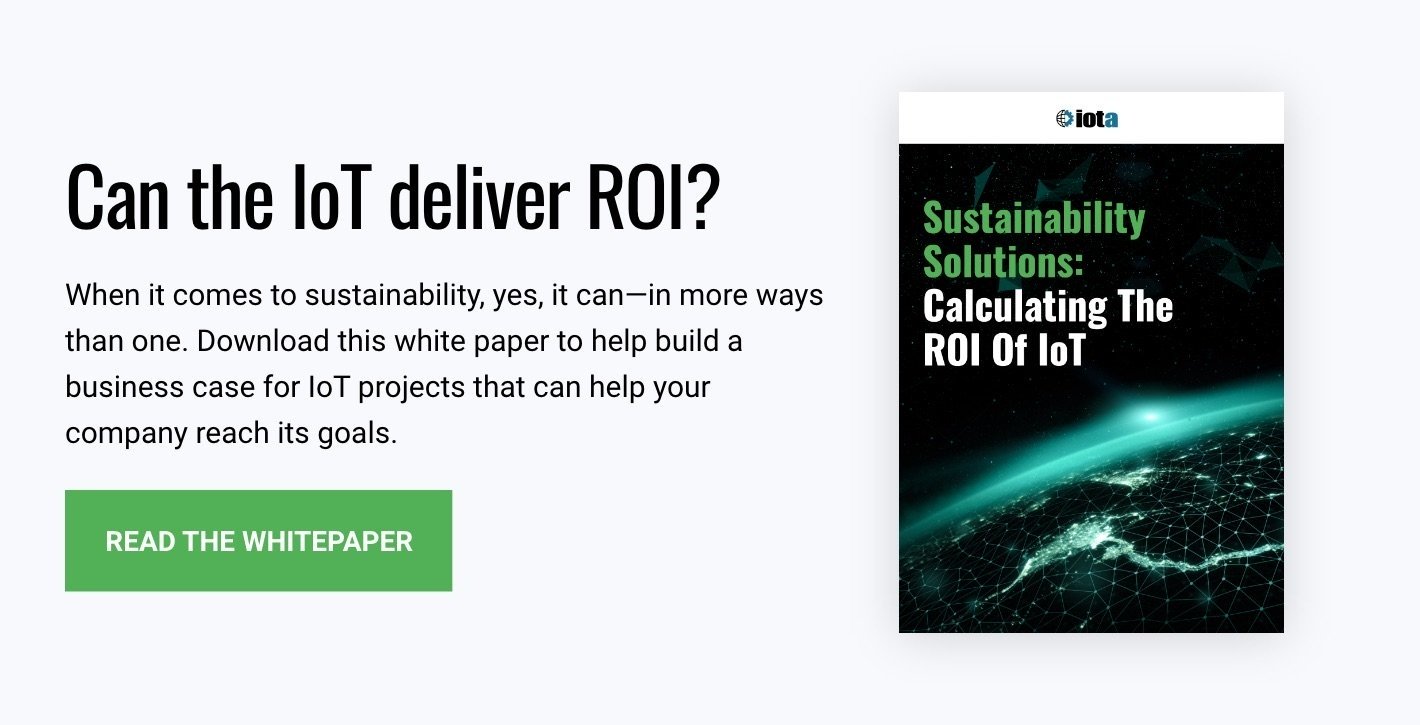These days, big data analysis is guiding companies in the search for answers to their most pressing process, marketing and sales, and HR questions (including ones they didn’t even know they had!), such as “How is our newly acquired software impacting our performance?”; “What should the marketing campaign look like for our upcoming product?”; or “Which of our employees are most likely to leave in the near future?”
Data-gathering and analytics are being used across many areas of business to not only learn what is happening now, but what is likely to happen in the future—and what should be happening to create better outcomes.
[bctt tweet=”The environmental aspect of sustainability is ripe for quantitative analysis. That’s where the Internet of Things (IoT) can help companies shine.” username=”iotacomm”]
Big data and sustainability also go hand-in-hand. With ESG investing booming as of late (environmental, social, and governance being the main measures of sustainability) and sustainable practices increasingly in the spotlight, companies need better ways to understand their current stances with regard to sustainability as well as how they can improve. Though some facets of ESG are difficult to quantify—social and governance factors among them—the environmental aspect of sustainability is ripe for quantitative analysis. That’s the sweet spot for sustainability analytics, and where the Internet of Things (IoT) can help companies shine.
Sustainability-related IoT projects pay off in more ways than one—download this free white paper to find out why the investment is well worth the cost.
Sustainability Analytics: Using Data To Analyze Your Environmental Impact
Business intelligence data traditionally comes from a variety of sources—business transaction systems, customer databases, market data, social networks, and more. Another data source gaining prominence is IoT sensors. IoT sensors now make it possible to collect business data that was previously difficult to capture, for example, information about the precise location of business assets or how customers are using a company’s products.
But IoT data can be leveraged for more than just financial performance; it is also well suited for reaching sustainability goals. IoT sensors can continuously monitor, measure, and catalog data related to each of the major areas related to sustainability:
- Energy use is a major component of sustainability because it is a direct contributor to greenhouse gas emissions. IoT sensors are capable of continuously monitoring your facility’s energy use.
- Water is an important sustainability metric because it is a primary component of everyday usage within most facilities. The amount of water your facility uses can be measured continuously.
- Air quality is an indicator of occupational safety and health; IoT sensors can monitor continuously to detect the presence of common pollutants such as volatile organic compounds (VOCs), carbon monoxide, and particulate matter (PM).
Having the ability to capture granular data around these three aspects of environmental sustainability makes it possible to measure and evaluate your company’s performance in a transparent manner, and even provides a roadmap that can help you improve.
The Sustainability Process Blueprint Approach
Companies serious about becoming more environmentally responsible can use what we call the Sustainability Process Blueprint Approach to continuously progress toward sustainability-related goals, whether those goals include achieving zero-carbon emissions, reducing water waste, or anything else. If your goal is to reduce energy use, for example, the process would look like this:
- Define your sustainability goals and related metrics that will help you assess your performance in those areas. There are several heuristic approaches to energy efficiency that reduce your facility’s energy consumption by 0%-to-15% and thus commensurately lower GHG emissions.
- Deploy IoT devices to remotely monitor the aspects of your environment you want to focus on. Energy use sensors monitor the energy consumption of all your building systems continuously, whether you’re there or not, so you can see where, when, and how your energy is consumed.
- Benchmark your data in comparison with industry peers and your own expectations to see how well your facility is performing. There is data provided by the Department of Energy with regard to energy benchmarking that can give you insight into your current performance.
- Curate different data types to assess your building’s typical operations, taking into account the variety of factors that play into your building’s energy use pattern (for example, weather data, cyclical or seasonal factors, occupancy data, etc.). Cataloging the data in a quantifiable format enables faster time to insight and provides information about your efficiency performance.
- Employ analytics to devise improvement strategies. Otherwise “invisible” building characteristics can be transformed into quantifiable data points that can be used in a statistical or analytical model for context. For example, an energy monitoring system will reveal your building’s total daily electrical consumption and the role individual devices play in your overall energy use. That data, combined with occupancy and weather data, for example, may reveal areas that are over-ventilated, wasting energy; or specific pieces of equipment that use excess energy.
- Share your quantifiable data with stakeholders to demonstrate improvement in environmental practices. For example, your company can use IoT data to show a reduction in energy use, which can then be translated into a quantifiable reduction of greenhouse gas emissions—i.e., As an example, based on the average energy consumption from the DOE, a typical office facility of 30,000 square feet uses 728,000 kWh of electricity per year. A ten percent reduction in energy consumption would translate into 62 tons reduction in CO2 emissions. As a result, both investors and customers have a way to “see” how sustainability efforts are making a difference.
Even a minimal reduction in building ventilation—just a couple of hours per day—could potentially reduce energy use by 10%.
Business Sustainability: Analysis On A Broader Scale
A sustainability analysis is grounded in operational data. But in the future, it may become commonplace for other types of business data to be blended with operational data to give a broader view of sustainability—a kind of “Balanced Scorecard” approach.
Platforms like Tableau and Dundas allow companies to merge data from numerous sources; combining and cross-examining that data often reveals patterns that can be used to optimize business processes across departments. In business, sustainability data merged with other data sets can also show some correlation among variables that were previously thought to have no relationship—a discovery that has the potential to produce valuable insights as a result.
For example, consider a business that runs an expensive, delicate printing operation. One facet of environmental monitoring is air quality: How much harmful dust particulate matter is in the air of your facility? You may be measuring air quality primarily for environmental reasons, but examining that data in relation to product quality could reveal that a high level of dust particles correlates with poor product quality tests. When two separate (and seemingly unrelated) data sets—quality testing data and air quality data—are merged and examined, you may be able to determine that better air quality actually produces a better product.
Curating disparate data sets in this way and visualizing the results helps you see and define relationships between variables that weren’t clear before. When you better understand what’s behind your company’s productivity, you have a solid foundation for continuous process improvement—and a roadmap for moving forward.
Want to get your company started with sustainability analytics?
If you’re interested in using data science for sustainability purposes, get in touch with us at Iota. We’ll work with you to develop goals and metrics, and determine what aspects of your facility should be monitored to achieve your objectives. Our IoT sensors can be tailored to your specific needs, and our advanced analytics and machine learning service will help you understand the sensor data and derive actionable insights from it.
We’ve helped numerous companies become more sustainable using the power of data, and we can do the same for you. Set up a discovery call with us today to learn more.


